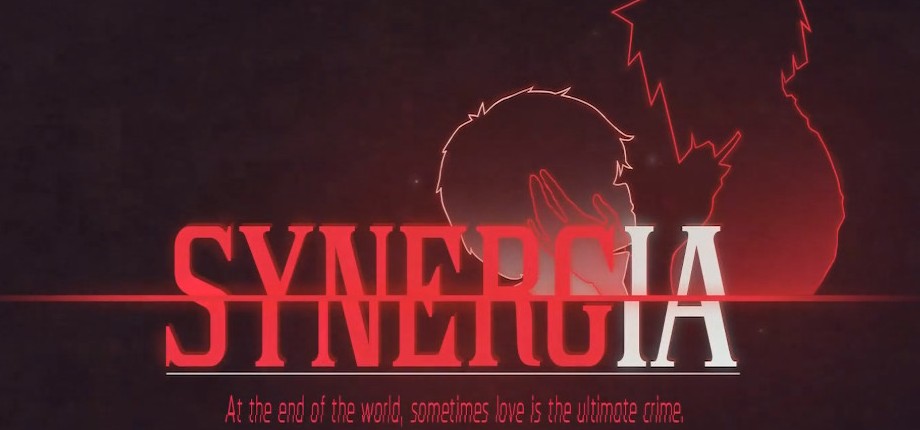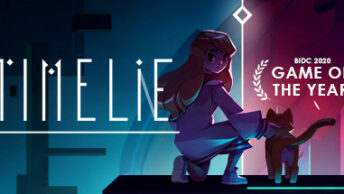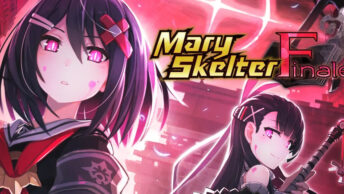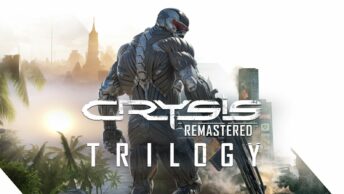Delightfully depressing dystopia dames dating.
Type: Single-player
Genre: Visual Novel
Developer: Radi Art, Top Hat Studios
Publisher: East Asia Soft
Release date: 18 March, 2021


Intro
I turn my collar up and keep my hat down to the keep the rain out as I walk the smokey streets. I’d stay and linger, enjoying the feel of the rain in spite of the cold, but they’d make me upgrade my weather subscription plan if I stayed too long, and I’ve got to save what I’ve got left in my account for rent and nutrients. The glare of the neon Corpo-brand advertisements reflects off the puddles on the street as I briskly march through the back alleys towards the teeming crowds near the market. It’s then I remember the other half of this game’s dual genres when I see her just staring at some of the old-model companion androids in the shop windows. Pieces of junk, what does she see in them? They’re so… fake and artificial, and definitely not attractive standing there anatomically correct and naked in the shop window which I’m definitely not staring at. Of course, that’s not what she sees in them. She’s looking at them with fascination, seeing the humanity I try desperately not to see. If I don’t pull her away from here, I might just see things that way, too, so I grumble at her angrily that we’ve got no time for this, and head someplace comfortably dehumanizing…
Those Old Time Blues
The roots of cyberpunk lie in film noir detective stories as much as science fiction. This is partly why the worldbuilding of cyberpunk stories tend to be more wonderfully incidental than boring exposition dumps, at least until they’re revealing the big conspiracy the gumshoe detective main character was tasked with unraveling. The setting is more about mood in a way that stretches out back to those noir films that ask you to bask in that smokey car with the hard-drinking detective who just wants to forget his past. (Or in this case, one taking heavy mind-altering drugs that stop her from sleeping on company orders to suppress “impulses” that are totally not nefarious or part of the conspiracy she’ll uncover.)

Naturally, our heroine has a dark past she’d rather live down and takes those drugs to help suppress the memories. The problem is, they interfere with her day job of being basically the private military company version of robot police, where she gets called in to take down psychotic cyborgs and androids with rogue A.I.
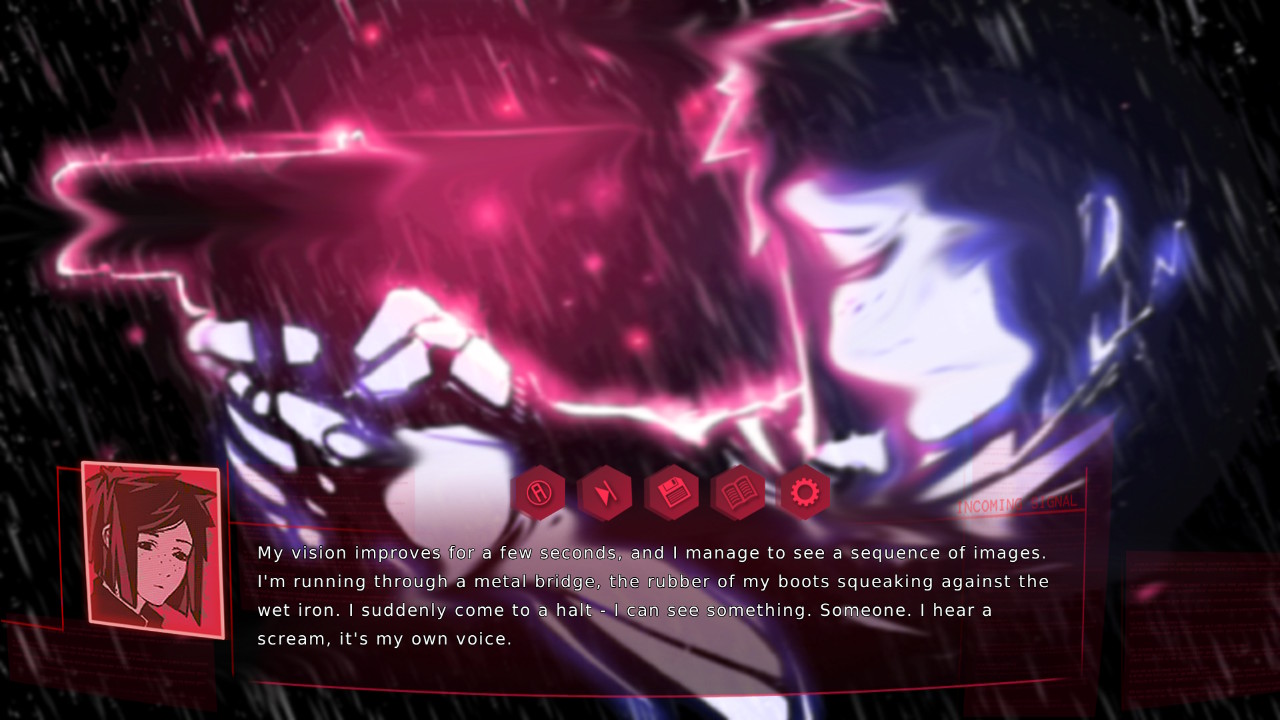
Speaking of the genre of cyberpunk, however, this game takes flagrantly clear inspiration from the OAV version of Ghost in the Shell. (Well, and the subsequent anime GitS: Stand Alone Complex, I suppose.) The main character can feel a bit more Blade Runner at times, but the overall aesthetic of the series is leaning heavily on GitS. That said, this is also a yuri game, so I can’t avoid mentioning Pandora in the Crimson Shell, the yuri spin-off series of GitS set in the same universe… but with a totally different genre, namely being a romantic comedy that uses its sci-fi to parody the magical girl genre. I’m not sure if the author of this work doesn’t know about PitCS, or just didn’t like the genre shift and complete change in tone (because this one just bathes in the paranoid depressive state of the OAV GitS’s cyberpunk), but Syngeria really does feel like it sits directly between the two series, especially since the love interest character initially comes off much more the optimistic idealist type much like PitCS’s protagonist that hijacks the tone into being light in spite of its subject material by pure force of personality. (Speaking of protagonists and tone, however, I feel compelled to add in somewhere, even if there’s no good place to do so, that Ghost in the Shell’s original manga form had a very different Matoko Kisaragi who was much more expressive, and she and Batou were more of a buddy cop duo with Matoko being the cop on the edge one.)
With that said, there’s also always been both the speculative fiction and the social commentary/political elements to cyberpunk that have always necessarily been more blunt in cyberpunk than the noir it developed from.
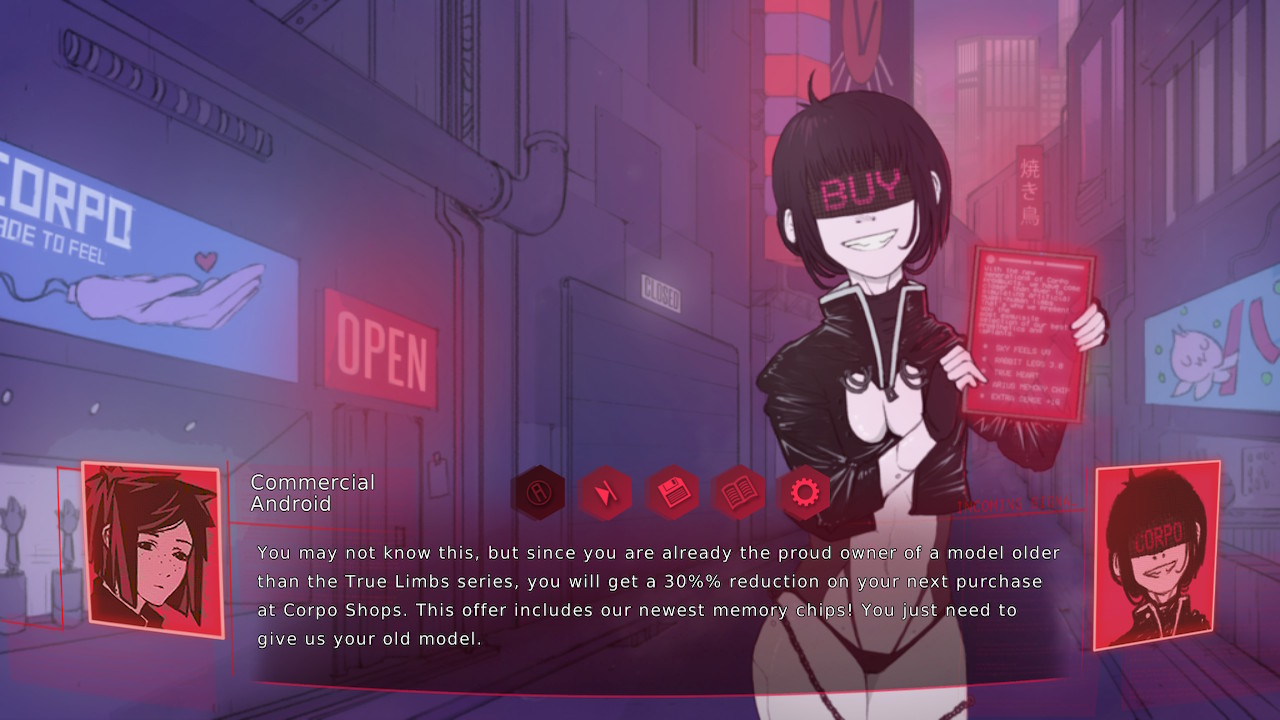
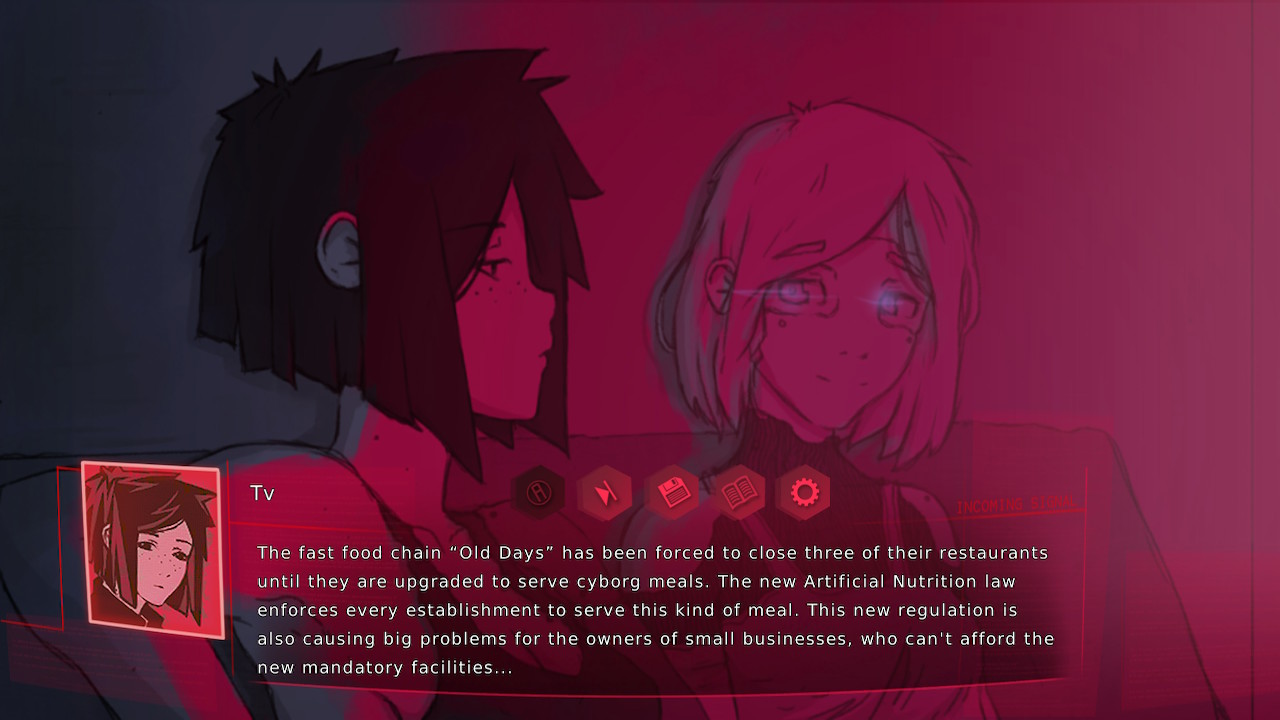

The Couple
With that said, if you’re going to like this game, then liking cyberpunk is just one of the populations you have to exist within in the Venn diagram, with the other being people who like watching anime girls kiss.
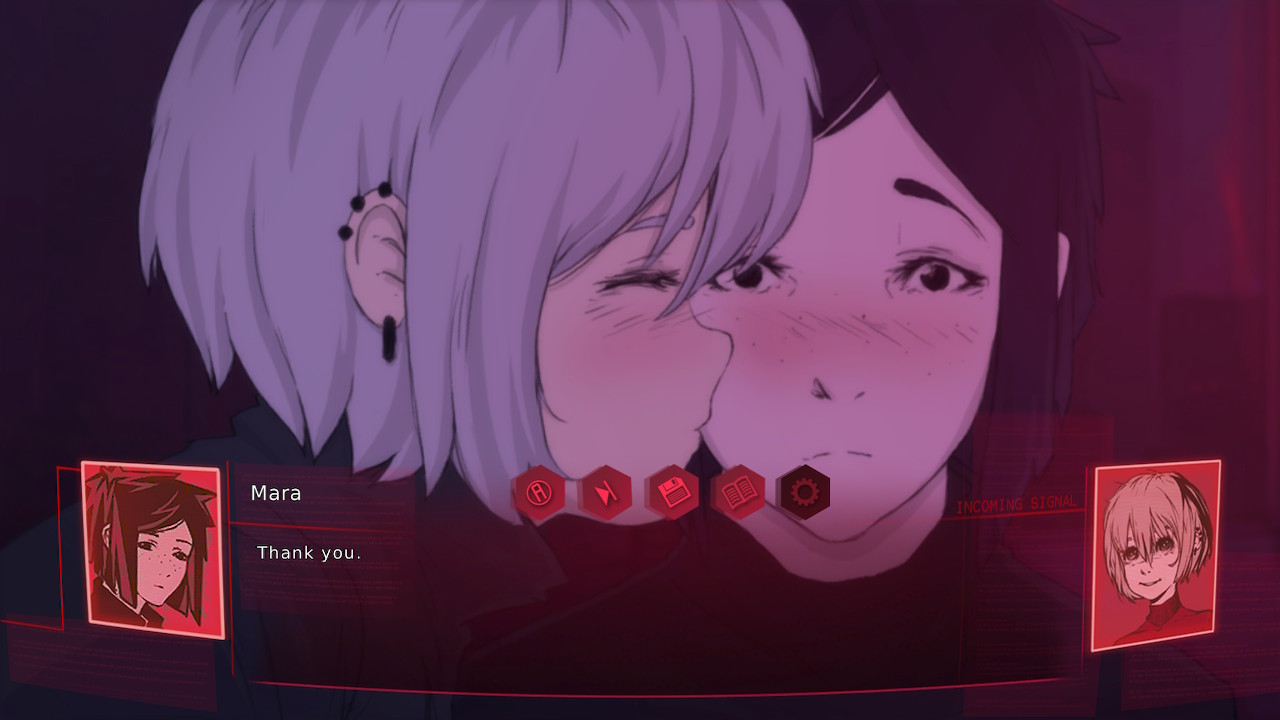
While cyberpunk tends to downplay the characters in order to make them more archetypes for what they represent and have the main character be more of a cypher so as not to ruin the show with unnecessary exposition so the scene’s mood can take over (after the lesson of the original theatric release of Blade Runner), Synergia is half a cyberpunk film noir mystery while the other half is just a cutesy romance between two women where one of them is technically supposed to be artificial.
With that said, it’s been a trend in cyberpunk and other dystopian sci-fi settings to portray the robots and androids as the most “human” member of the cast, often as a way of emphasizing the dehumanizing nature of the dystopic setting. To quote Ellen Ripley after discovering one of her fellow survivors is an android, “I should have known. No human being is that humane.” Compared to the bitter, black-clad Cila, Mara is a Polyanna who instantly lights up Cila’s life with her vivacity and interest in everything she sees around her. In another type of story, she’d be the Morality Pet, and even looks fairly child-like, but she starts turning much more crafty and an able companion to Cila as the story goes on.
In the meantime, however, the game does have its scenes where they try to make them a cute couple. After Cila lets down her “she’s just an android, don’t get attached” guard, there’s the actual romance section, which does manage to make it seem cute and homey. That said, I do think that for a game where this relationship is the core to the whole motivation of the main characters, more time could have been spent on fleshing the relationship out. The story starts chapters stating it’s X days until the Synergia Incident, but it also skips about ten of them in the middle when the relationship is supposed to be blooming and Cila goes from “she’s just a machine” to “I’m ready to turn on everyone else I’ve ever known and die for this girl”.
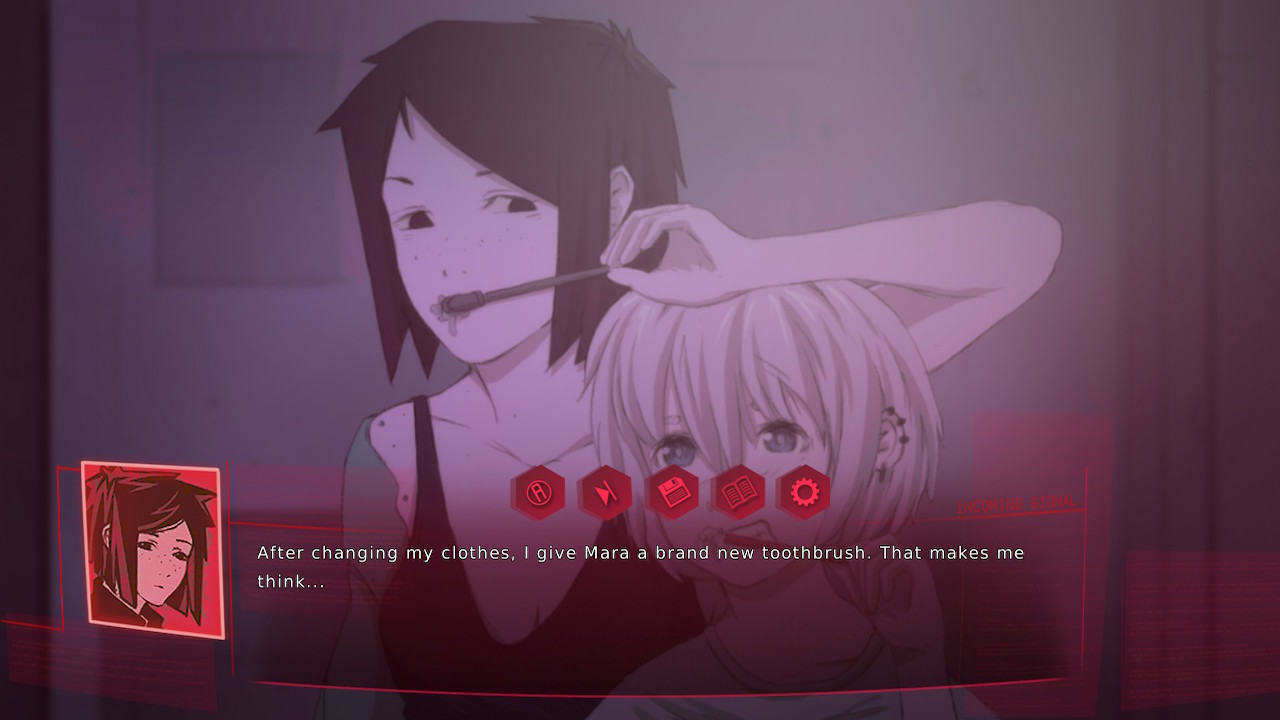
Frankly, the extent to which “bioroids” (androids made of organic materials) are made human (up to the point where they cannot have information downloaded into their brains and instead need to be taught like human children) winds up making any attempt to play Mara as anything but a human a bit silly, making this just a forbidden lesbian romance with sci-fi just being an excuse to make Cila not instantly bang her new roomate that she’s clearly into and is clearly into her.
Speaking of that sci-fi excuse for angst, it’s illegal in this game world to have sex with an android. (Although not to have a platonic relationship with one… but then, they do make ‘companion androids’. Plus, the game introduces this alongside talking about how the emperor has his own sex gynoid dungeon.) This idea is played around with early in the game with Cila’s old android, Elaine. Cila has, in her bid not to grow romantically interested in her companion gynoid, constantly shut down all Elaine’s “features” (artificial quirks that make her behave more like a human) until she’s basically a walking Alexa app. Elaine isn’t long for this world, however, as she would get in the way of the romance that’s supposed to bloom between the two mains, so the author – I mean – mysterious forces dispose of Elaine after her narrative purpose is complete.
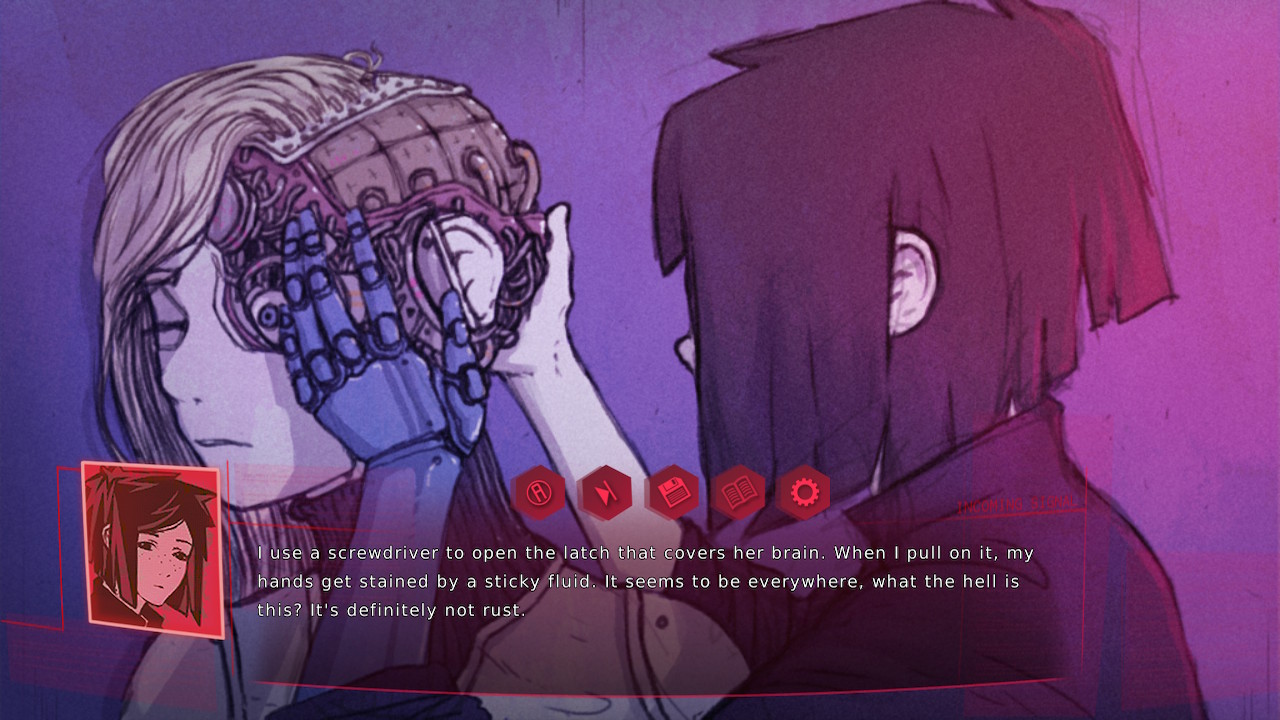
The people of this planet (oh, yeah, the game just casually mentions that this isn’t Earth halfway through the game – surprise!) apparently are required by law to follow a ‘religion’ called Humanism, which is supposedly the worship of the divinity of humans in contrast to machines, but basically it just exists to be the vague pseudo-fascist bad guys that try to outlaw all the robots and stop the yuri because the plot would be boring if you just had two people like each other and everyone was cool with that. Outright making being a lesbian illegal is too overdone, so they just focus on the human and basically-a-human romance part being illegal, instead.
While it should be fairly obvious, I should again stress that this is yuri, and that there’s some clear gender bias in what gets written or drawn by the developer. While it’s not like every male character is evil, they’re often portrayed antagonistically while they portray even female characters in roles opposed to the main characters as being nuanced and like you should sympathize with them on some level. With that said, there’s an awful lot of gaze to be drawn to the female body with this character design. If those sorts of things aren’t your cup of tea, you should probably pass on this one.
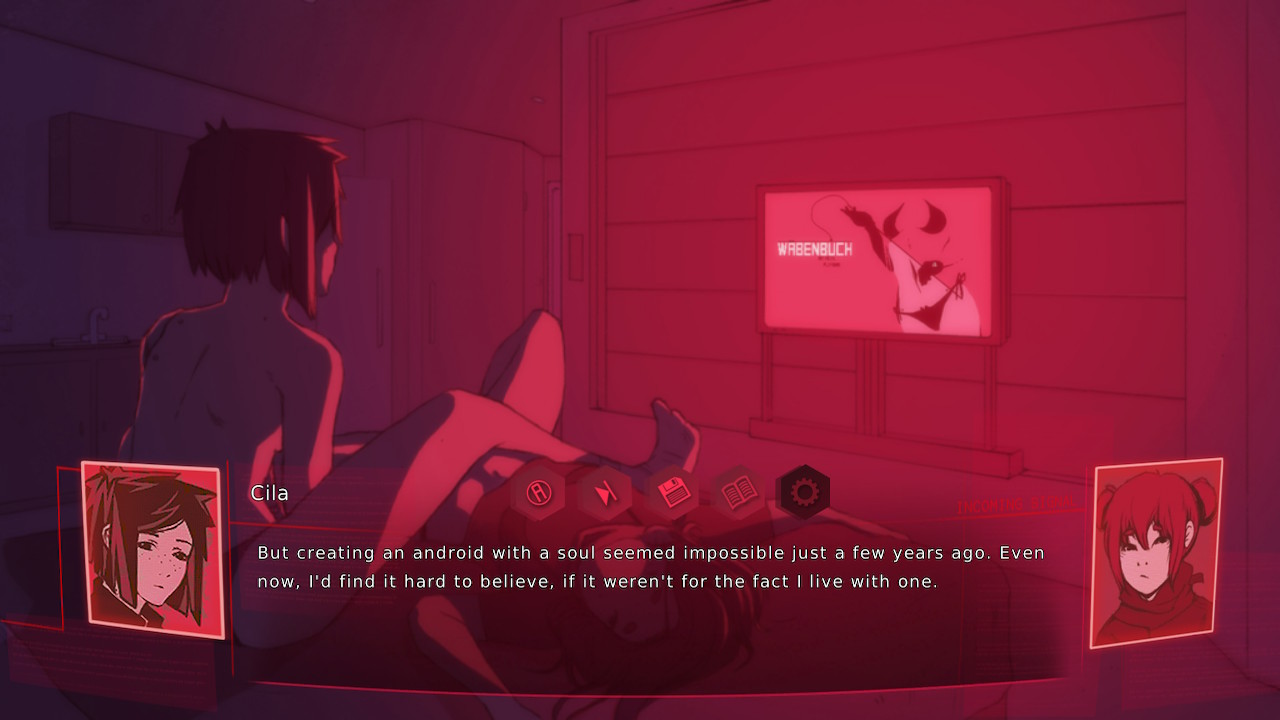
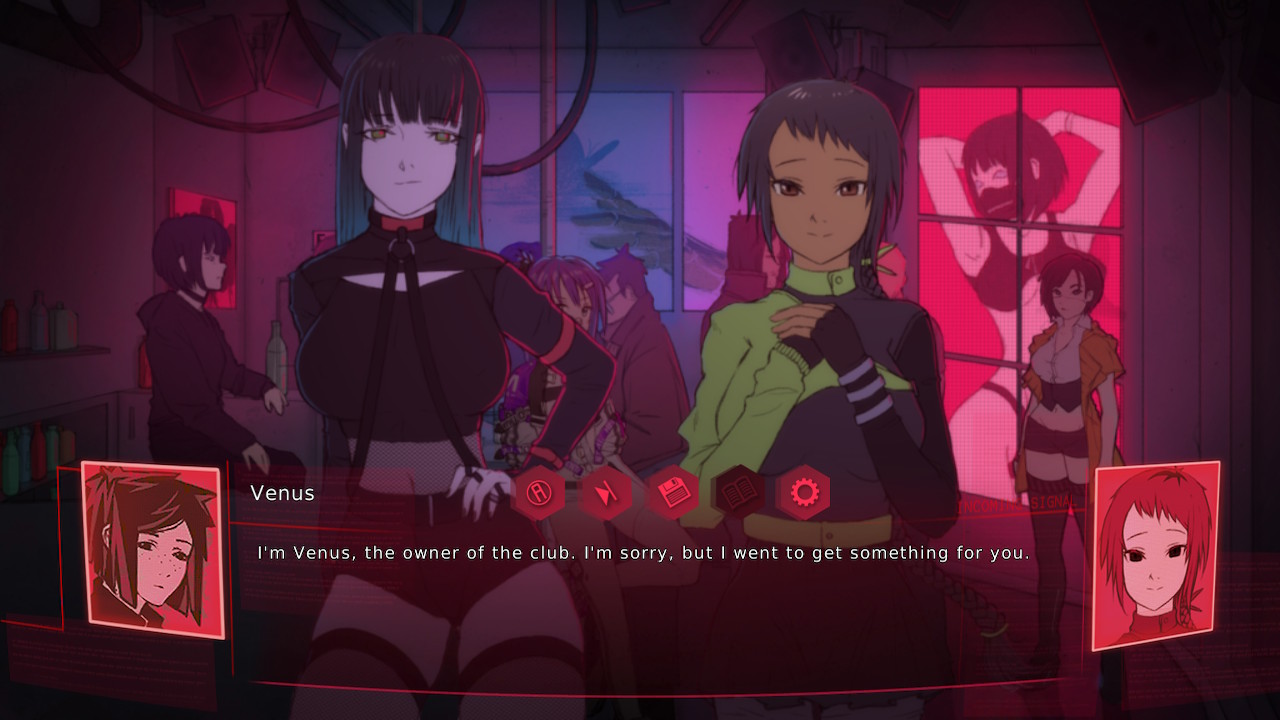
Graphics
The artwork in the game is rougher than the more polished works of many visual novels, which tend towards using the same few key frames all the time. Synergia’s quicker art style, however, tends to look more like what you’re looking at is a storyboard for a spin-off Ghost in the Shell anime that never got greenlit, and all the effort that didn’t go into making highly detailed finished scenes and characters instead went into adding more variety to the scenes and more action shots.
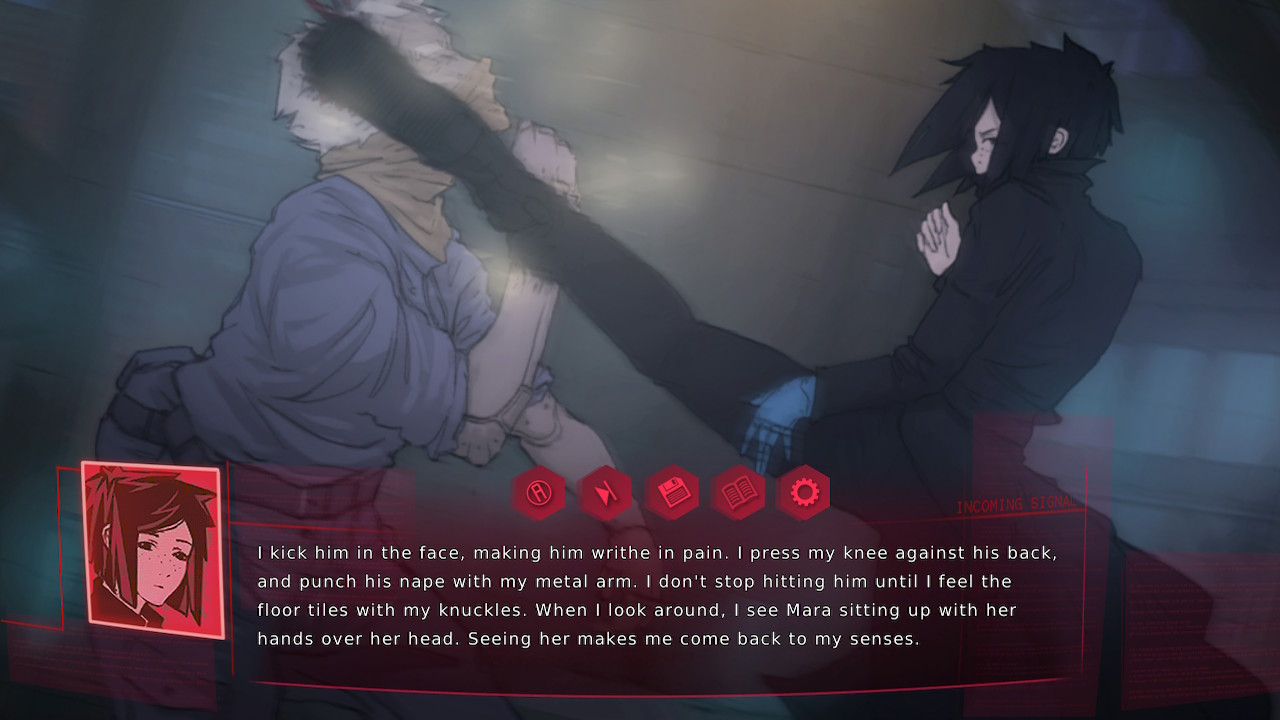
I think what clinches it for me, however, is the art direction overall. Synergia has a very limited color palette, with most scenes being painted entirely in white, red, and black. Diving into Holospace (their version of cyberspace) turns the world cyan and purple. Computer interfaces are the rare splash of blue… and then are all blue. The constant neons and pastels without any grounding earth-tones help sell a mood of a continuous drug haze-like surreality to the world.
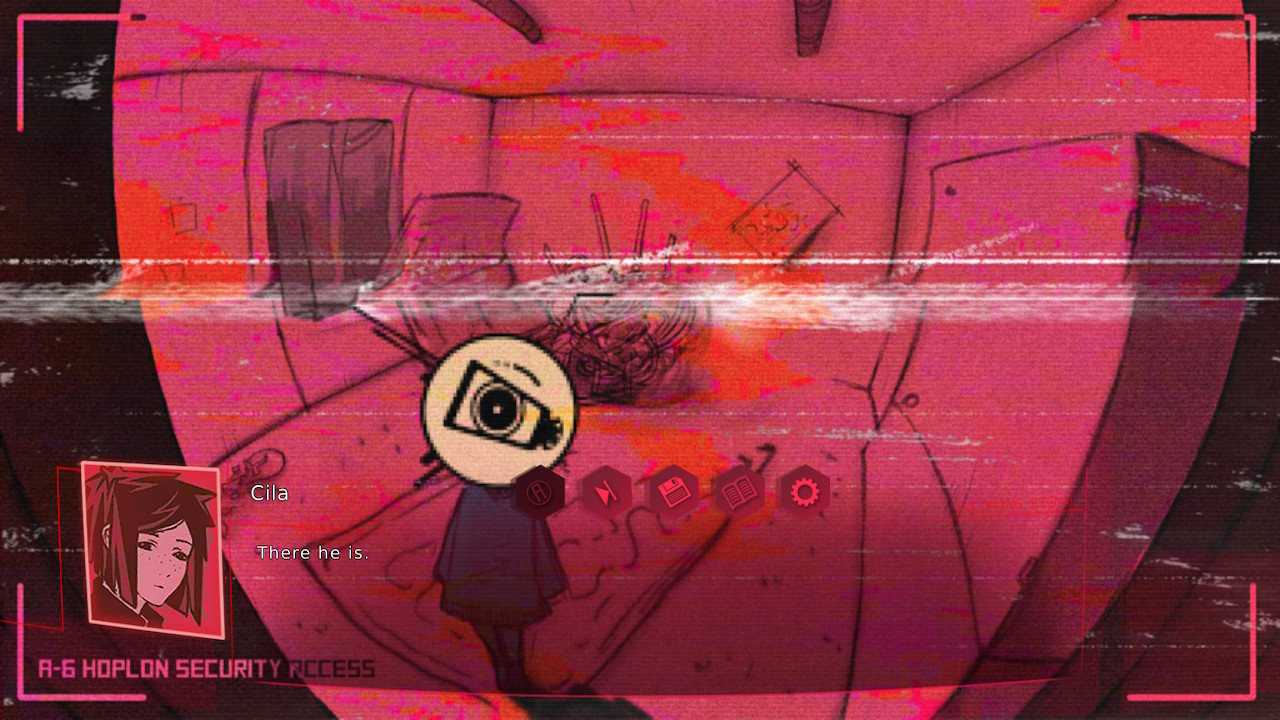
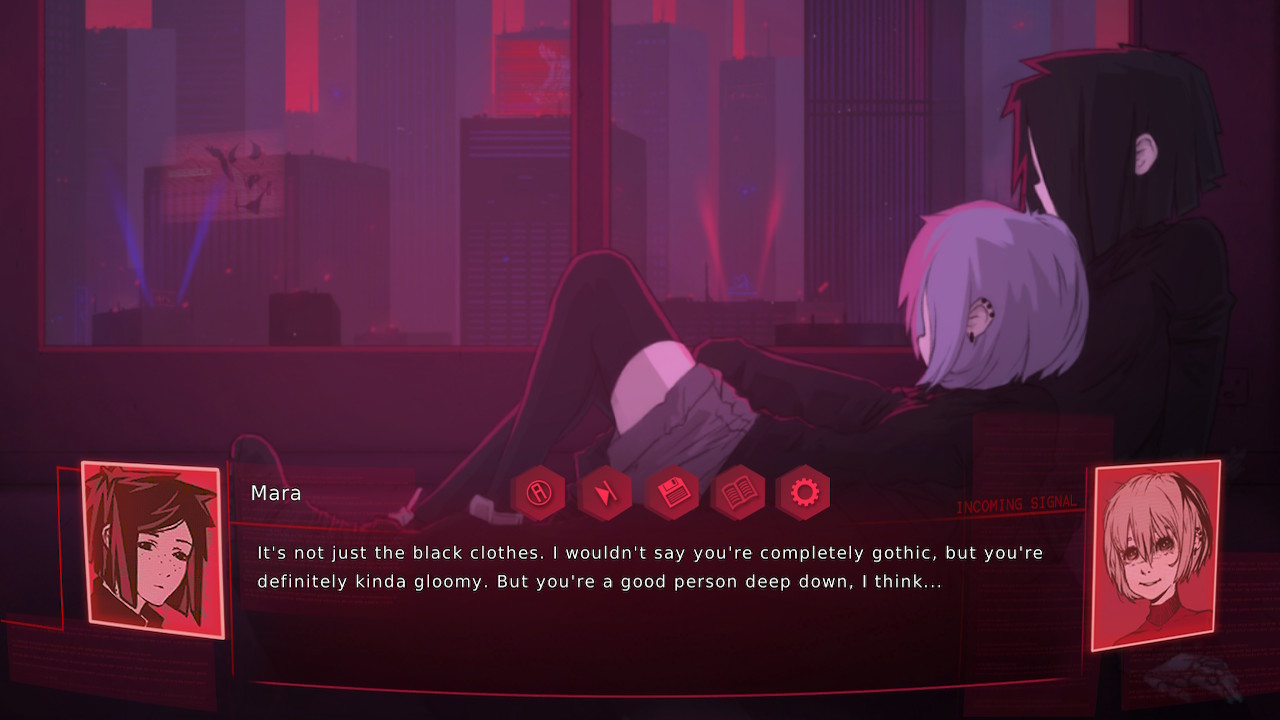
Synergia makes good proof that you don’t need fancy graphics to make a striking game with a lasting impression. The artwork is on the level where I feel like even I could make a good crack at it, but it also winds up being more striking and memorable than much more big-budget games. In a genre perhaps better known for its visuals than its storytelling, Synergia is using every ounce of what it has in its budget to sell its mood.
Sound
The number of sounds are fairly limited, but Radi Art uses its limited arsenal to the best of its ability. I don’t think I’m getting the soundtrack (they do sell the soundtrack on Steam), as they’re clearly background mood pieces, but as background mood pieces, they’re great stuff.
Sound effects are also well-suited to the mood of the piece, although as an amusing aside, if you leave the game hanging on a part of the story where a sound effect is supposed to happen, the sound effect just repeats after a few seconds. This can lead to something like that Simpsons episode where characters are trying to add more one-liners into a conversation in a fake action scene and constantly keep cocking their guns over and over (which would lead to them ejecting all their ammo on the floor).
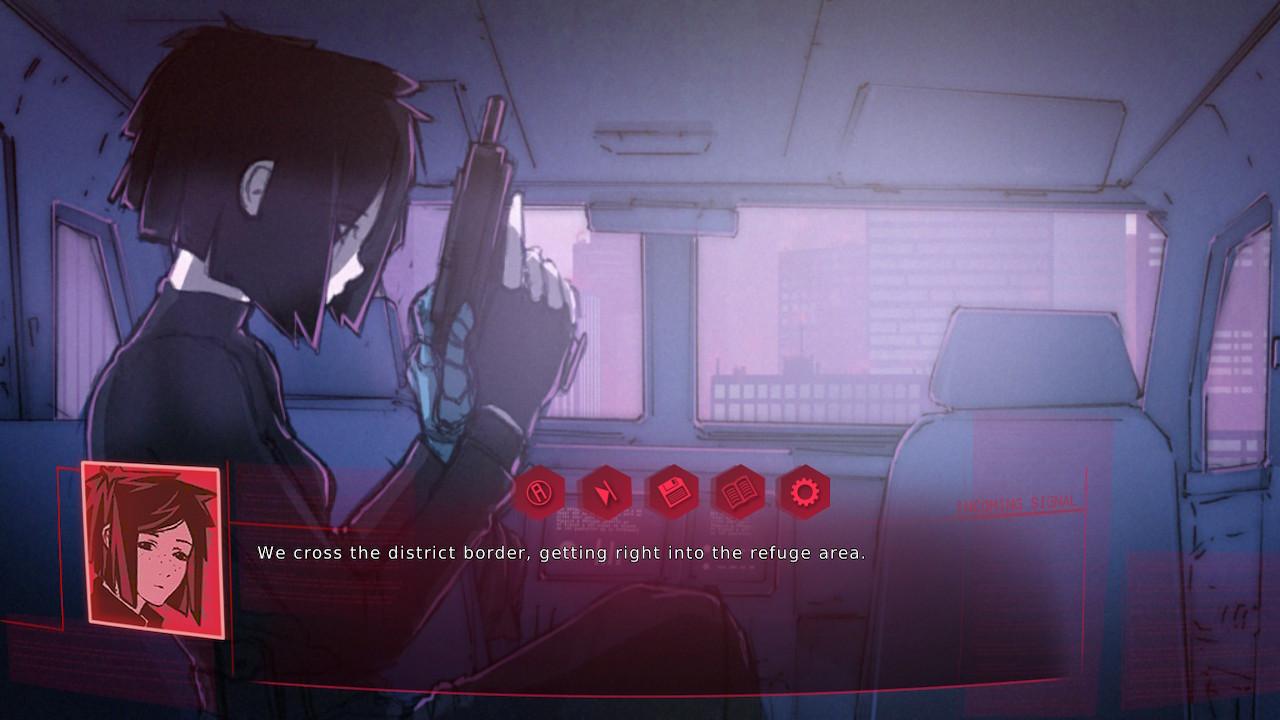
Choices
There aren’t that many choices in Synergia, this is more of the “cinematic experience” type of visual novel. What’s more, the choices are the type where it changes a few lines of dialogue early on, but then seems to go on like there’s nothing different, only for it to be a choice with consequences you couldn’t really predict a couple hours down the story. (Reload a save.)
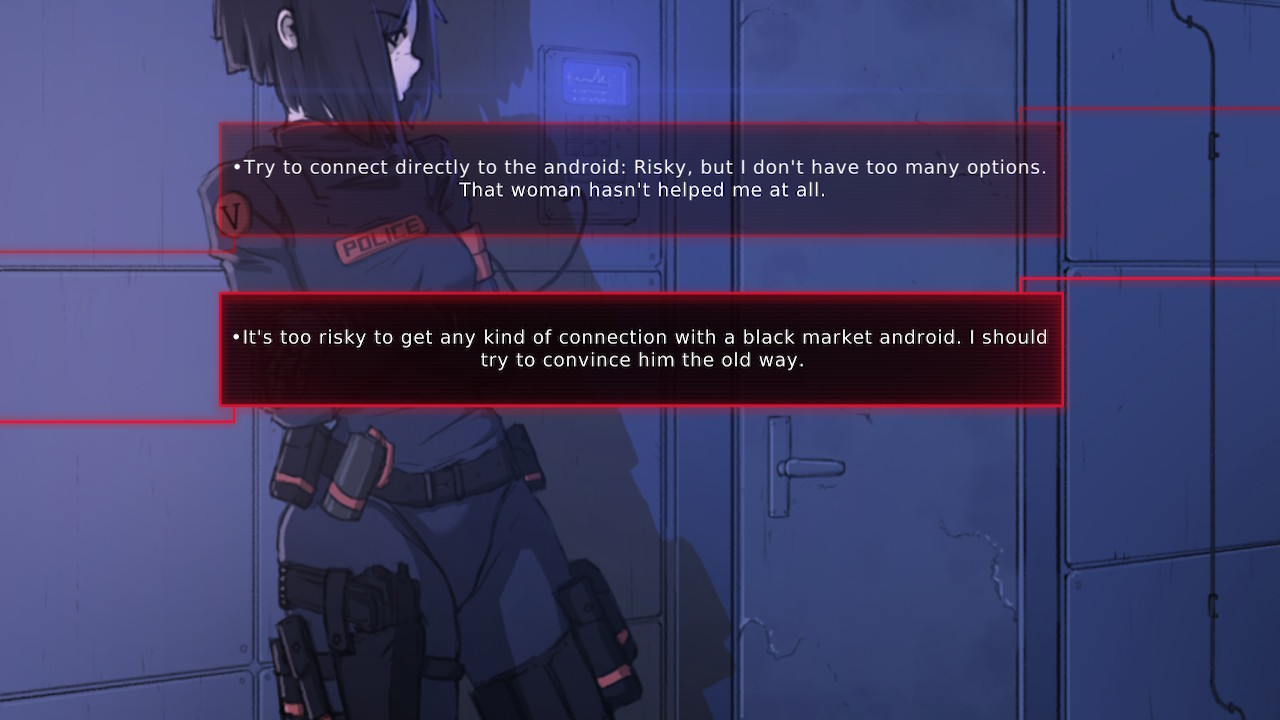
The occasional use of computers gives you a pseudo-desktop that often gives you more choices, as although you’re basically only there to punch one button then go, the ability to look at news stories or archives gives you a chance to dig up foreshadowing for the player without having Cila actually comment upon things the player won’t recognize, but Cila would.
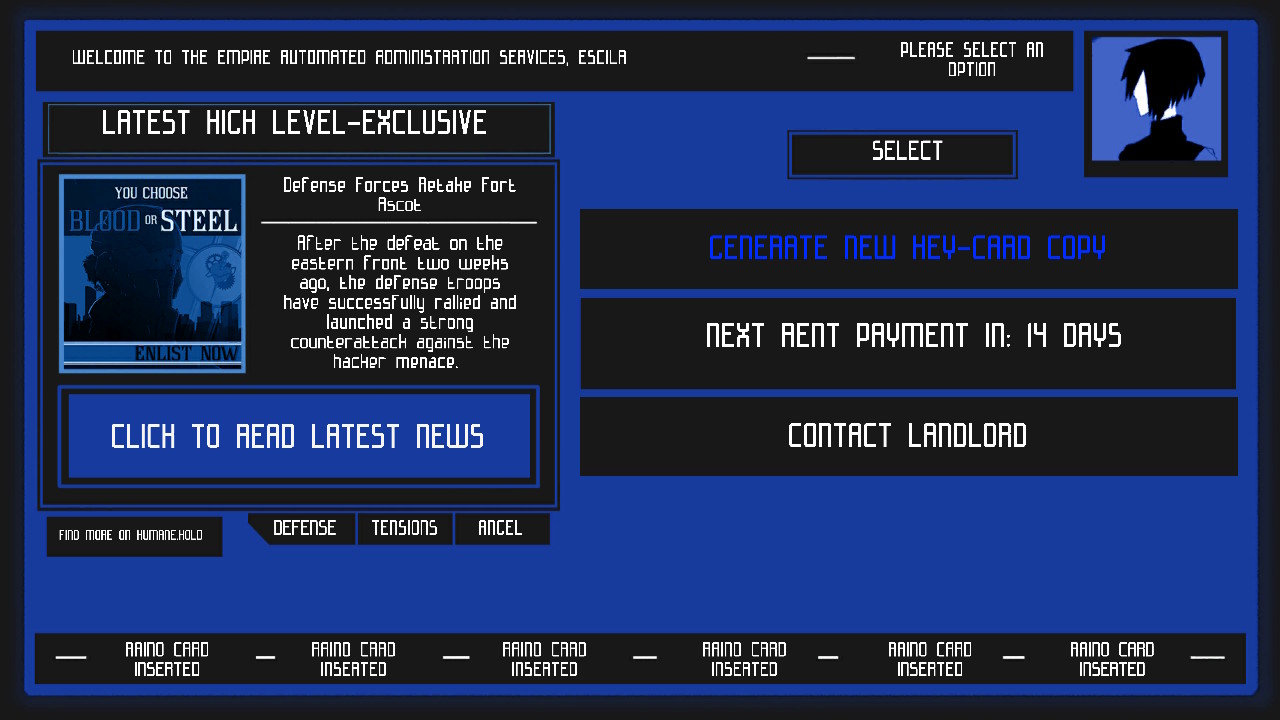
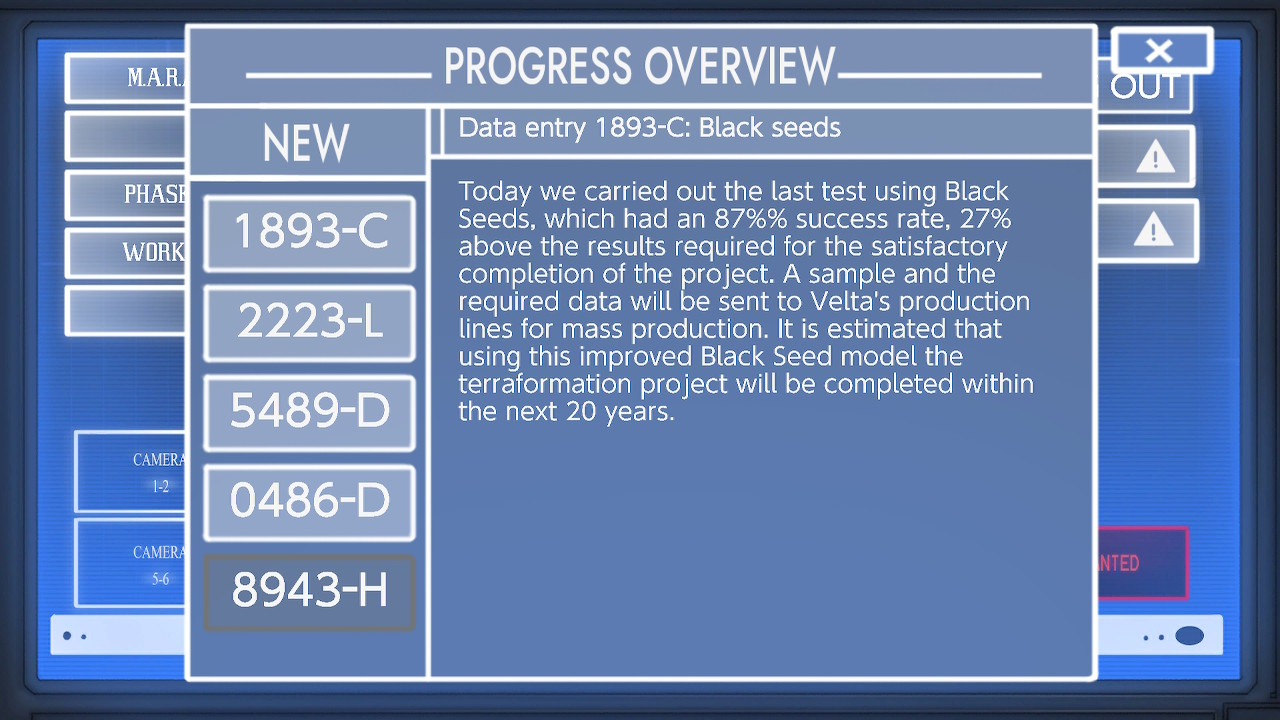
In terms of player choices when it comes to playing the game, meanwhile, you’re also facing a limited number of options. You have your usual volume and text speed choice (I’ve never understood why instant isn’t the default),
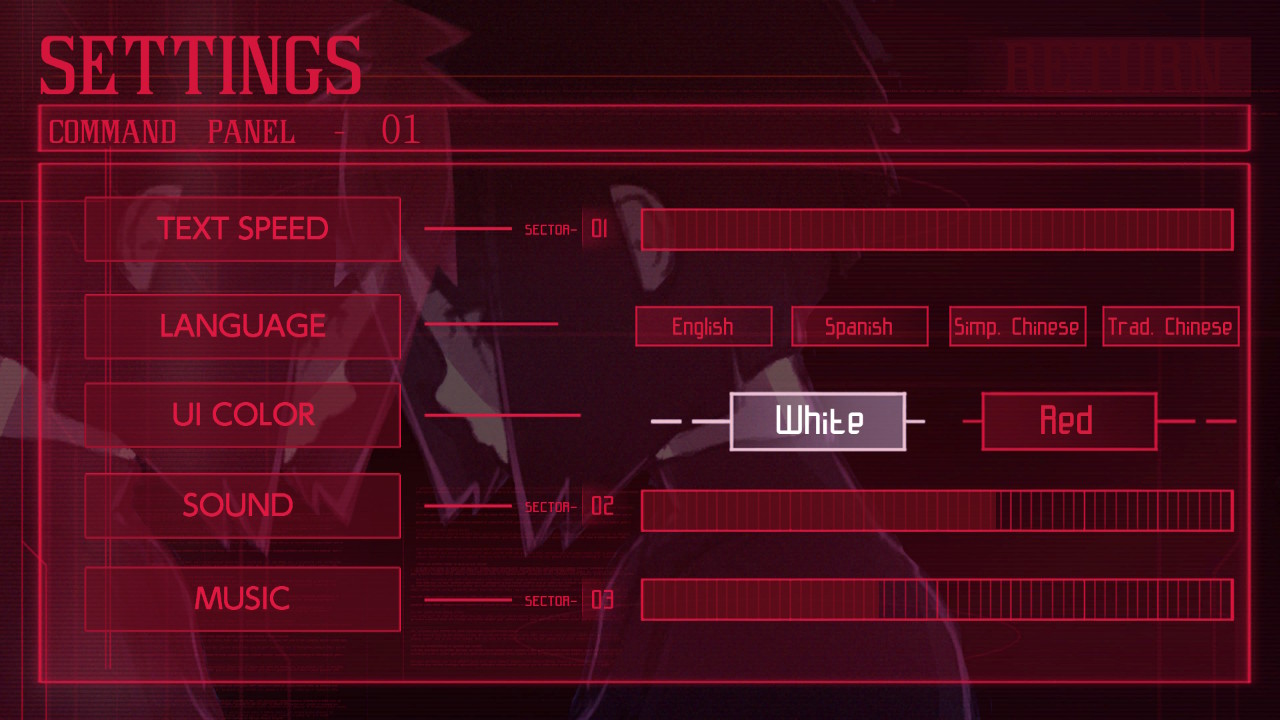
The background color palette tends towards red, so it will match more of the game if you pick that, however.
The Port
East Asia Soft, the guys who also did the Switch port for Bishoujo Battle Cyber Panic is apparently also in charge of Synergia’s port. I found the menus a little clunky there, but the game was overall fine.
Synergia, however, has some controls (which cannot be rebound) that are just strange.
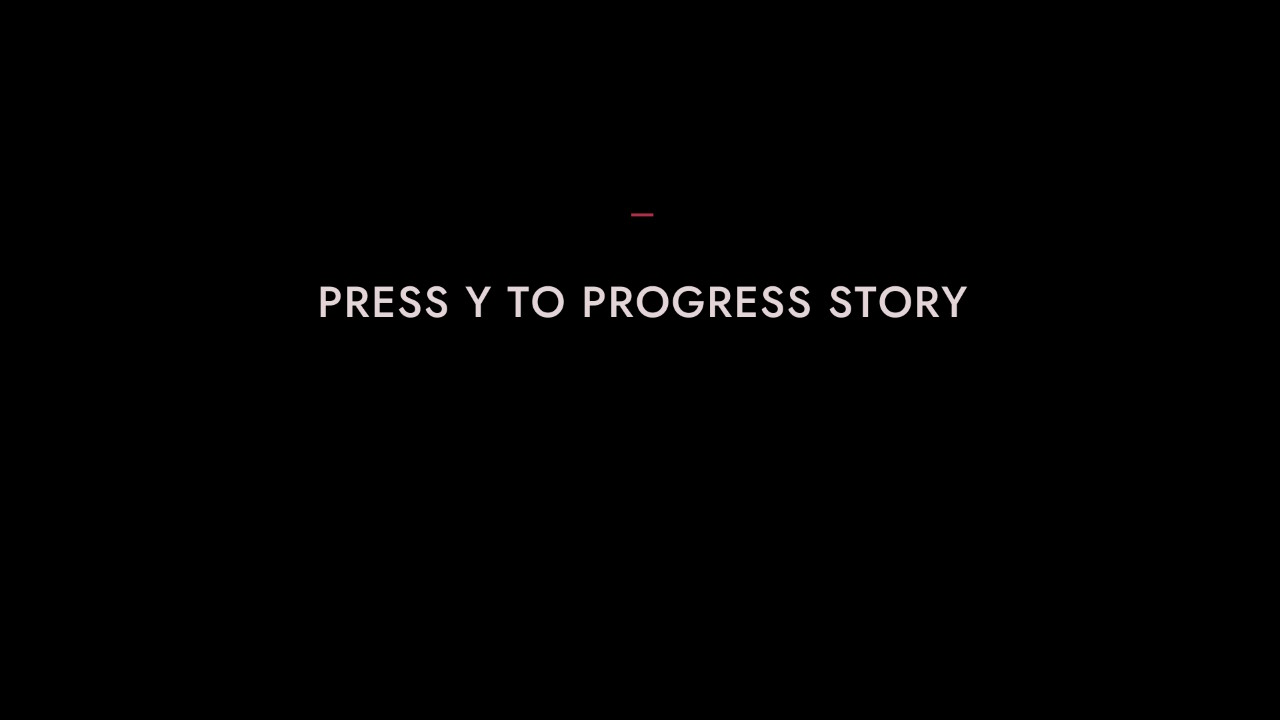
The A button is used to navigate menus like normal, including those brief interludes where you’re using a computer interface. Otherwise, however, it activates one of the big red buttons which defaults to starting auto-text advancement. You have to mentally adjust to not using the main button you always use on the Switch for advancing text, then this game throws you a curveball and makes you advance text with A just to trip you up as soon as you get back out of the menu. It’s a minor gripe, but it’s needlessly annoying, and considering as it was the job of someone totally unrelated to the original game’s team who made all these choices, and these choices are all wrong, it leaves me wondering if I should ding the review just for the port, or give the game that I like made by people who were doing a good job a good score.
There is no way to make the text disappear, and the big red icons over the text are new to the Switch port, and also don’t go away. This can sometimes interfere with seeing the character art or backgrounds.
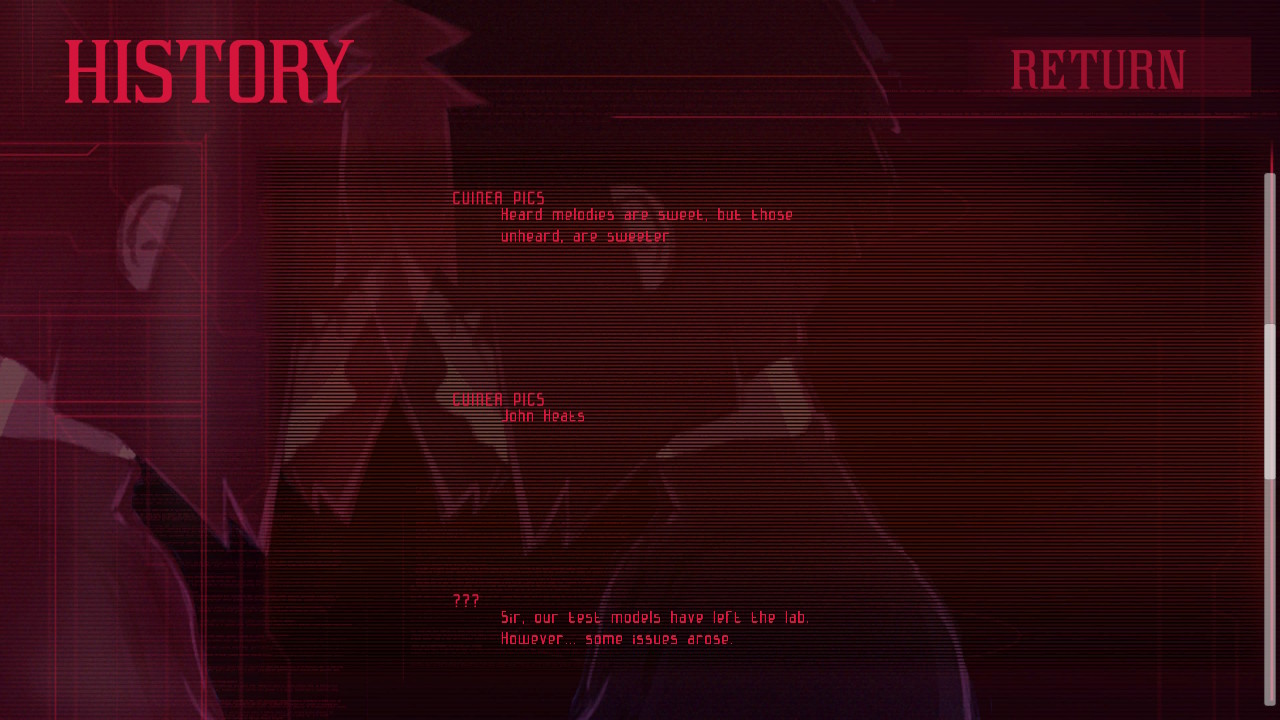
Verdict
As a picturebook you need to punch a button to keep advancing, this is great stuff, so long as cyberpunk’s your genre. In terms of sci-fi, the story may not push boundaries with its concept (well, unless you think having lesbians in it is still pushing a boundary), but it nails the pure mood of cyberpunk perfectly. I want to stew in its depression.
With that said, it may be worth getting on Steam, instead, as the controls are weird on Switch, and it’s lower price on Steam as well.

